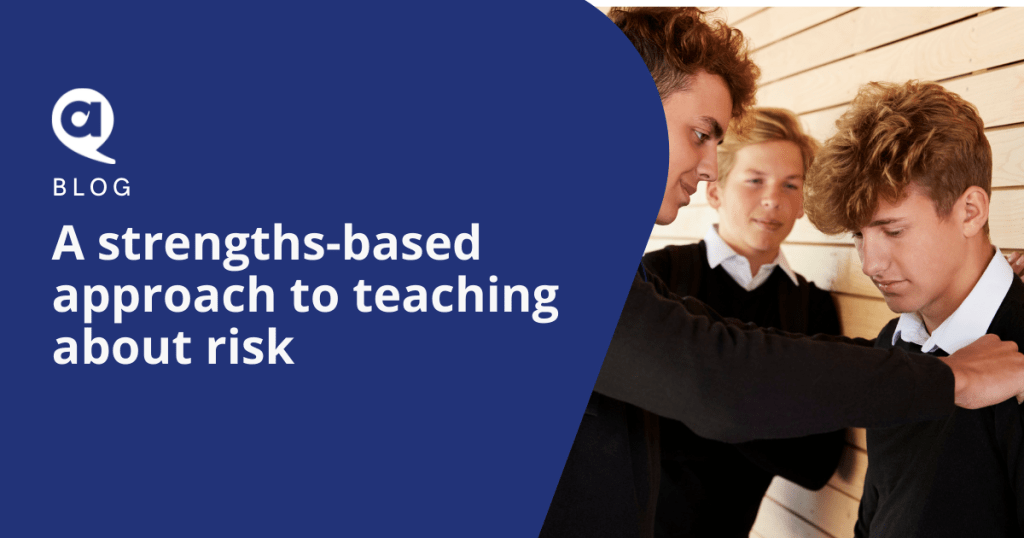

1 June 2022
By Janice Atkin, ACHPER NSW Professional Learning Officer
The strengths-based approach is based on the salutogenic model of health and takes a broader focus on the development of personal skills and building capacity to access and engage with community resources. It recognises that the skills, resources and capacities available to each student will differ immensely and proposes that “one size fits all” interventions (incl. school PDHPE programs) do not account for these variabilities.
It is a shift away from the deficit model where the intention has been to “immunise” students against any harmful or risky situations they may encounter or protect them against potential dangerous, unsafe, unhealthy or risky behaviours. The way we have taught about risk previously is we as adults have presented scenarios that we judge to be risky, dangerous or unsafe. The shortfall in this approach is that it is based on the assumption that everyone will either be exposed to these risky situations, engage in risky/unsafe behaviours or make risky or unsafe choices – which we know is not the case for the majority of our students.
When teaching about risk and safety it is important to present scenarios in an open-ended fashion. A single scenario is not in itself inherently risky or not, the context which the situation is occurring more often than not creates the risk.
Let’s explore the following scenario:
Your friend told you that the school bully has threatened to bash you up after training. You have to walk home alone because your parents are both at work.
When you first explore the situation many of you and your students may determine that this is a high risk situation because there is an impending threat of violence … but is it? If we unpack the scenario more fully we might help students to think a little differently:
- The bully hasn’t directly threatened you – at this point it is only your friend who has said they have threatened to bash you.
- The scenario doesn’t say whether you are already at training or still at school – if still at school you could decide not to go to training and head straight home or tell a teacher what you have been told and they could intervene / assist. If at training you could organise to travel home with someone else.
- You have the opportunity before you need to walk home to speak to an adult who can help you in this situation – either a coach, a parent of another player to ask for help.
- You could contact your parents and discuss the situation with them – they may be able to leave work to pick you up from training.
So when using scenarios to discuss and explore risk ensure that the focus is on providing students with the tools to make their own decision about the level of risk involved based on a framework that acknowledges the contextual factors at play and empowers students to take some control over the situation.The following questions provide a framework to support discussion about indicators and levels of risk:
- WHO are you with? who else is around?
- WHAT are you doing? what are you being asked to do? what are others doing? Do you have to do what you are being asked or is there an option not to do it?
- HOW are you feeling about the situation?
- WHY do you think you feel this way about this situation?
- WHERE are you?
- WHEN is this happening?
As part of the process of determining levels of risk of different scenarios it is important to also explore students’ skills, capacities and resources which they can draw on to manage the situation and minimise the potential for harm. So for example if we look at the scenario of:
You know your uncle is coming over to a family lunch. He makes you feel uncomfortable and always wants you to sit on his knee and give him a hug.
Firstly you would want to breakdown the situation using the question framework above. At this point in the scenario there is little to no risk involved as you are not in the situation – you have options in how you will react and the choices you can make to reduce the level of risk. The most important question in the framework for this scenario is the WHY do you feel uncomfortable? It could be because your uncle has bad breath and is smelly or it could be because he cuddles you too tight or puts his hand on your leg (a much riskier scenario). Next we should look at what are the options for responding to this situation:
Before the family lunch
- You could tell your Mum or Dad how your uncle makes you feel and ask them to intervene if he asks you to sit on his knee
- You could talk to another trusted family member who will be at the lunch and ask them if you can spend the afternoon with them to avoid your uncle (if you didn’t feel comfortable talking to your parents)
- You could ask your siblings or cousins if they feel the same way and as a group go to speak with your parents about the situation
During the lunch
- You could refuse to sit on his knee if he asks and explain why you don’t want to
- You could avoid being near him so he doesn’t get the opportunity to ask you to sit on his knee
- You can make sure that you are always with someone else during the lunch so your uncle can’t single you out.
After the lunch
- If your Uncle still tries to make you sit on his lap and touches you in an inappropriate way you should tell a trusted adult about it as it is not OK for adults to touch children in ways that make them feel uncomfortable or unsafe.
There are many options but not all will work for everyone depending on the skills they have (communication, assertiveness, refusal skills, self awareness, awareness of rights, and help-seeking strategies) and the resources they have access to (eg supportive family, older siblings, other trusted adults, access to support agencies, school counsellor / welfare staff).
In developing programs and teaching and learning activities we need to ensure that we recognise that the experiences, skills, resources and capacities that each student brings to the lesson will differ immensely. As such a “one size fits all” mentality to responding to a “risky” situation. It’s important to teach students that there is no one “right way” to respond to a situation – the right way will depend on the context and the individuals in the situation.
By avoiding a one-size-fits-all mentality we also remove the presumption that all students are unsafe, taking risks, or making bad choices. If the focus is on developing skills and practical strategies that work for the individual and applying those to a range of different situations (including situations where they may be exposed to risky, unsafe or unhealthy choices/behaviours) we send a message to all students, no matter what their background or life situation, that they have the skills, knowledge and capacities they can draw on to support them to make healthy, safe and less risky choices.


